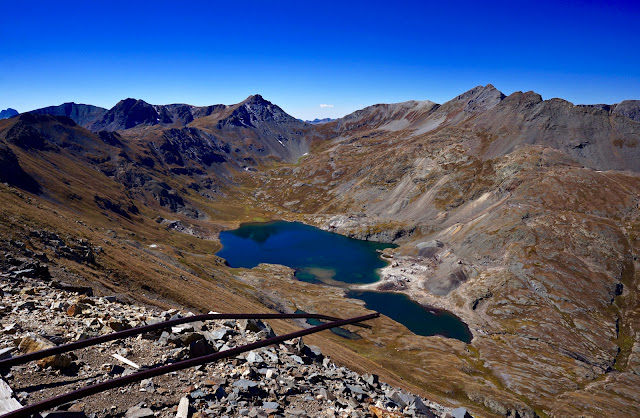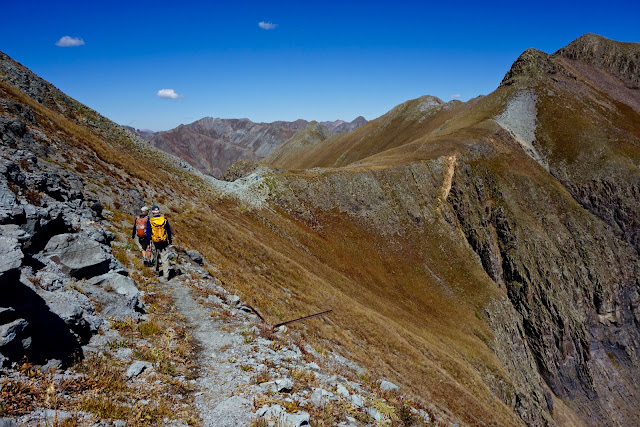Travel: From the US 160/550 intersection in Durango drive 28.5 miles north on US 550. At the apex of the hairpin at the bottom of Coal Bank Pass (south side), turn left. 2WD vehicles with good clearance should be able to negotiate the potholes on the dirt road as far as the standard Cascade Creek Trailhead parking in 0.7 mile just before the road crosses the Cascade Flume. Walk 0.8 mile up the road to the Red Gate. 4WD vehicles may proceed to the Red Gate Trailhead, 1.5 miles from the highway. The road is rough after the flume parking. Allow 45 minutes from Durango.
Distance and Elevation Gain: 17.0 miles; 3,600 feet of climbing from the Red Gate Trailhead.
Time: 7:00 to 9:00
Difficulty: Trail; navigation easy; no exposure
Map: Engineer Mountain, Colorado 7.5 Quad
Latest Date Hiked: September 28, 2016
Quote: I go to nature to be soothed and healed, and to have my senses put in order. John Burroughs, 1837-1921
Three quarters of the route around Engineer Mountain may be seen from Graysill Mountain located west of the Cascade Creek drainage.
Route: From the Red Gate Trailhead at 9,120 feet, walk northwest up the Cascade Creek Trail. Bear northeast on the Engine Creek Trail to the junction with the Engineer Mountain Trail. Turn east and contour under the southern slopes of Jura Knob. The trail turns south. Pass Creek Trail, the blue-line route, comes in from Coal Bank Pass on the east and Engineer Mountain lies west. Descend six miles to the Engineer Mountain Guard Station and go northwest on the Cascade Creek Trail back to the incoming road. Turn right and walk 0.2 mile to close the loop at the trailhead.
Pass Creek Trail to Engineer Mountain Guard Station segment hike: For this alternative, it is 2.5 miles from Coal Bank Pass with 1,200 feet of gain to the Engineer Mountain Trail. Descend six miles to your shuttle vehicle at the Engineer Mountain Guard Station. For the car drop, take a left off US 550 one mile above the Cascade turn at mile marker 52.2 and proceed 0.2 mile to the trailhead. [2021 Note: the Pass Creek Trail is now called simply the Pass Trail.]
Walk through the Red Gate portal. Cascade Creek Trail #510 utilizes an old roadbed to the first creek crossing and then narrows to a single track.
This loop would be untenable in early summer runoff. However, if your quest is the Cascade Creek waterfalls, visit in June. At that time there are little secret stashes of elusive fairy slipper orchids hidden in the forest and shiny red columbine in sunny patches. Please see the Cascade Creek post for information on the elevated wooden flume.
Pass through a large meadow with a view of Graysill Mountain.
In 2.6 miles, cross Engine Creek on a footbridge. In early summer this double cascade is a thundering torrent. Engine Creek Trail #657 is just another 0.1 mile hence at the beginning of an open meadow. Watch for the sign tacked to a spruce tree and turn right.
Initiate a gentle climb through a fir forest, watching for wildlife. The idyllic trail stays northwest of the Engine Creek gorge most of the way to the junction with the Engineer Mountain Trail. Pass through interludes of meadows framed by Colorado blue spruce and aspen. Peak autumn color typically occurs the third week of September. The forest floor has its own particular beauty: yellow myrtle blueberry, red geranium leaves, and opaque, white snowberries. (THW, photo)
Cross a side stream at 4.0 miles. The trail steepens briefly on some switchbacks around 5.2 miles. Openings in the forest become more prevalent. The northern prominence is Jura Knob. Be sure to turn around occasionally for a dynamic view of Engineer's fierce, north face escarpment. Rock hop across a substantial tributary creek with an elongated waterfall series.
The crossing of Engine Creek proper occurs as the treadway emerges into an open expanse just below treeline with a view of Jura Knob. The junction with the Engineer Mountain Trail is about 0.3 mile off. Meanwhile, the footpath swings slightly west. (THW, photo)
At 6.3 miles, 11,500 feet, come to a major junction where four tracks join. Our upcoming Engine Creek Trail ends here. Make a hard right turn to the east on the Engineer Mountain Trail. (Northbound, the Engineer Mountain Trail tracks along the west face of Jura Knob and meets the Colorado Trail in 1.4 miles.)
Also at this intersection is the White Creek Trail. It contours southwest under Peak 12,703' to connect with the Colorado Trail in 2.9 miles. This beautiful link trail is favored by mountain bikers.
Walking due east on the Engineer Mountain Trail, look down on the Engine Creek Trail. First snow is here to stay on the shaded north face of the eponymous mountain.
This image was taken from the highpoint of our hike, 11,800 feet, at 7.6 miles. It looks back on Jura Knob, elevation 12,614 feet. This route would be a very long way around to Jura but you could climb it from here handily.

Lest we forget this is a two season hike, here's a snap of a pointillistic field of flowers in the Jura region.
Momentarily above treeline, there is a grandiose, exhilarating openness and unmatched view of Grayrock Peak, 12,504', and Graysill Mountain.
With the exception of small undulations the second segment of this loop is an easy-going downhill flow. For now our view is captivated by the spell-binding, commanding fulcrum of this circuit. A rock glacier blankets the entire northern base of the mountain, a sure sign of exfoliating tumult.
At 8.2 miles, the Engineer Mountain Trail passes the junction with the Deer Creek and Coal Creek Trails. See the Jura Knob post for an explanation of these two routes. Stay straight on the Engineer Mountain Trail. Going south, the thin but well-trodden path takes aim at the low saddle between Engineer Mountain and Point 11,916', unofficially called the Engineer Plateau. (THW, photo)
At 9.1 miles, the Pass Creek Trail comes in from the east and terminates at the Engineer Mountain Trail at 11,680 feet. This is the 2.5 mile blue-line route on the map above. The segment hike from Coal Bank Pass to the Engineer Mountain Guard Station is a local's favorite but does require a shuttle. This juncture is the launch point for the Engineer Mountain, 12,968', climb. Here is the one place on the circuit solitude will likely be broken. Mid-summer, a walk up the Pass Creek Trail to look at the outrageous flowers in Engineer Meadows is a popular half-day outing. (Chris Blackshear, photo)
Engineer Mountain was sculpted by a 2,000 foot wall of ice sliding south during the Pleistocene. The trail skirts under the southeast columnar granitic wall.
The delightfully smooth dirt track plunges into a heavy spruce forest. The trail comes alongside the eastern edge of the drop with numerous overviews beginning at 10.9 miles. Back in the aspen zone, in autumn this trail segment is the highlight of the hike. US 550 wends beneath Potato Hill (a.k.a. Spud Mountain), and Mountain View Crest is the flat-topped plateau on the right. (THW, photo)
At elevation 10,700 feet, walk through a span of limestone. Grouse favor this biozone. Descend through open glades, one of which holds a pond glazed with flaxen leaves and lit by an autumnal fire. (THW, photo)
Take a last look back at Engineer Mountain. (THW, photo)
Coloradans are intimately familiar with the fleeting combination of brilliant aspen and deep, forest green conifer. The Animas River canyon is image-center. To its right is Electra Lake and then Cascade Village beside the highway.
(THW, photo)
The trail makes one long switchback to the north before sorting itself out and proceeding correctly south and west. If your timing is right, the trail is obscured by yellow leaves.
Reach the junction with the Cascade Creek Trail #510 at 15.0 miles, elevation 9,080 feet. For those doing the full loop, two miles remain. In the very center of this image is a sign post. Turn right onto a grassy 50 foot cutoff before hitting the main trail going west.
In the image below, a car is parked at the Engineer Mountain Guard Station trailhead. This is the end of the 8.5 mile section hike.
The very old and well-established Cascade Creek Trail is occasionally used by mountain bikers. It is marked with posts and weathered tree blazes. Psych yourself up for another couple hundred feet of climbing.
The trail rejoins the road at 16.8 miles. Sometime in the summer of 2016 the helpful sign designating this segment of the Cascade Creek Trail disappeared. Turn right and walk 0.2 mile to the Red Gate Trailhead. If you are parked at the flume, it should be a simple matter to cut down to the road earlier and save some mileage. The picturesque, private log cabins scattered in the woods have 99-year leases managed by San Juan National Forest.


















































